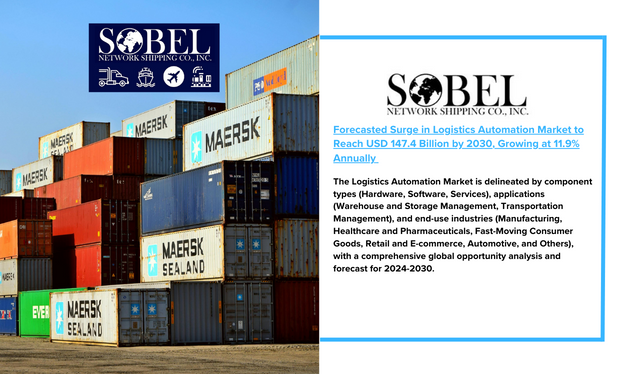The Logistics Automation Market is delineated by component types (Hardware, Software, Services), applications (Warehouse and Storage Management, Transportation Management), and end-use industries (Manufacturing, Healthcare and Pharmaceuticals, Fast-Moving Consumer Goods, Retail and E-commerce, Automotive, and Others), with a comprehensive global opportunity analysis and forecast for 2024-2030.
In 2020, the global logistics automation market was valued at USD 49.7 billion and is expected to soar to USD 147.4 billion by 2030, progressing at an annual growth rate (CAGR) of 11.9% over the decade.
The expansion of the logistics automation sector is primarily driven by the increasing demand to enhance efficiency, productivity, and cost-effectiveness in supply chain operations. Rapid advancements in technologies such as robotics, artificial intelligence, and data analytics are transforming traditional logistics processes. The need for real-time tracking and visibility, complex global trade operations, and the growth of e-commerce are key drivers for adopting logistics automation solutions.
Warehouse automation is a significant trend propelling market growth, prompted by labor shortages and the urgency for quick order processing. Automation technologies play a crucial role in making logistics operations agile and scalable, helping businesses remain competitive in a dynamic market environment.
In the industrial sector, logistics automation improves accuracy and efficiency. Automated systems manage complex tasks such as inventory management, replenishment of assembly lines, and packaging, allowing companies to adapt to demand fluctuations. Embracing lean operations and just-in-time manufacturing, businesses find logistics automation indispensable for enhancing supply chain processes and maintaining a competitive advantage.
In the pharmaceutical and healthcare sectors, stringent safety and compliance mandates boost the adoption of logistics automation. Automated solutions ensure precise tracking and traceability of sensitive items like pharmaceuticals and medical devices, minimizing risks of errors or contamination. These systems also enhance operational efficiency while ensuring patient safety and compliance with regulations, making logistics automation essential for a reliable healthcare supply chain.
The FMCG industry relies on logistics automation for efficient inventory management, order fulfillment, and accelerated delivery times to meet customer demands. Similarly, in retail and e-commerce, automated systems like warehouse management systems (WMS) and transportation management systems (TMS) optimize order processing and inventory management across multiple sales channels. Automating processes such as order routing and last-mile delivery scheduling enhances customer satisfaction and loyalty, proving vital for retailers aiming to thrive in the evolving market landscape.
At the core of logistics automation is the management of warehouses and storage, where technologies like robotics, RFID, and Internet of Things sensors enhance inventory accuracy and fulfillment efficiency. These technologies optimize storage utilization, reduce picking errors, and increase inventory transparency. Automation enables companies to increase order accuracy, cut labor costs, and streamline operations, transforming warehouses into sophisticated logistical hubs that meet the demands of modern supply chains.


